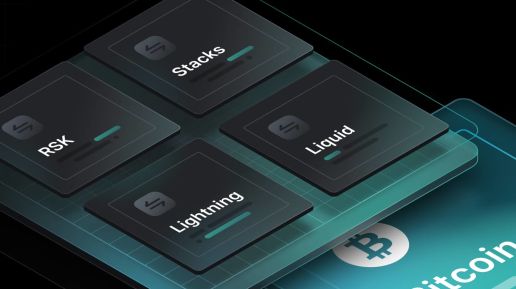Written by Lipsa Das for Trust Machines
Ordinals have been all the rage lately, but it's time to remember our good old Bitcoin layers. After all, layer 2 networks are core to making Bitcoin more functional and accessible for builders and bringing in new developers to the ecosystem.
Strap in, as we explore what is layer 2, the difference between layer 1 vs layer 2 functions and popular L2 protocols that are enabling builders to utilize Bitcoin’s potential.
What is Bitcoin Layer 2 and Why Does Bitcoin Need L2s?
Layer 2 blockchains build on top of the Bitcoin blockchain. L2s are the programming layer that introduce smart contract functionality, while the final settlement happens on Bitcoin, the base layer.
While Bitcoin is the gold standard for security and decentralization, it has often been criticized for its inflexibility and speed as Bitcoin strips down features of layer 1 blockchains to minimize complexity.
Bitcoin’s protocol was primarily designed as a peer-to-peer transaction network — and it does an incredible job at that. However, building applications on Bitcoin is often cumbersome because of a limited scripting language and finite programmability options. This can limit the range of applications built on the Bitcoin blockchain.
Additionally, some of the core strengths of Bitcoin — security and decentralization — come at the tradeoff of smaller block sizes and slow yet expensive transactions. Bitcoin's network requires an average of 10 minutes to create a block and 1.5-2 hours to finalize it.
These long transaction finality times can also pose significant problems for time-sensitive applications like trading transactions. Imagine waiting 10 minutes for a micro-transaction to complete on your game — nightmare! What's more, on-chain data storage comes at a high cost, which can make developing storage-intensive applications difficult.
Due to these shortcomings, developers have historically preferred alternative blockchains like the Ethereum network and Solana that were specifically built for smart contracts. However, that’s all changing with the popularity of layer 2 scaling solutions.
Building on top of Bitcoin: Level 2 Scaling Projects
Layer 2 solutions effectively preserve the benefits of the Bitcoin blockchain, while resolving scalability problems. Let’s look at some popular Bitcoin layer 2 projects and how they’ve increased Bitcoin functionality.
Lightning Network
Lightning network is a smart-contract-enabled layer 2 that allows for cheaper and faster transactions via the Bitcoin network. According to their website, settlement speeds are around 1-3 seconds per transaction, a significant upgrade from Bitcoin’s 10-minute transaction speed and all while maintaining the security of the underlying Bitcoin blockchain.
Like we saw in the case of El Salvador, the Lightning network has helped massively with Bitcoin adoption. You can now use Bitcoin to purchase your favorite goods at over half a million stores like McDonalds, Walmart etc, at ‘lightning’-fast speeds. In addition, solutions like Strike, Cash app, Bitpay, and more have integrated the Lightning network to further scale global payments.
Although the Lightning network first focused on payments, its layer 2 crypto ecosystem has since expanded to include music, games, and even DeFi apps.
Stacks
As one of the leading Bitcoin layer solutions with an active community, Stacks has been the center of many Bitcoin innovations, Ordinals included. Stacks enables users to mint NFTs natively, and over 650,000 Ordinal NFTs have been minted via Stacks.
Along with the Ordinals narrative, Stacks has also seen massive interest in its DeFi and DAO ecosystem. dApps like Trust Machines product LNSwap (trustless swaps), ALEX (decentralized launchpad), and LydianDAO (treasury management) have ushered in a new era of building on Bitcoin.
Stack’s design features a programming language Clarity that can read Bitcoin state and allow Bitcoin logic and a consensus layer that settles directly on Bitcoin. Further, the most recent Stacks 2.1 upgrade aims to make these features more accessible by reducing transaction fees and upgrading smart contract functionality.
Rootstock (RSK)
Rootstock (or RSK) is a layer 2 bitcoin project focusing on interoperability. Rather than reinvent the wheel, RSK’s native smart contract capabilities allow Ethereum mainnet applications to be compatible with the Bitcoin blockchain. It also addresses the shortcomings of the Ethereum blockchain by providing Bitcoin’s robust security and processing 10 times the number of transactions per second.
RSK streamlines multichain development — which has bought a ton of attention to the Bitcoin chain. Popular applications include Sovryn (a lending platform) and Tropykus (a savings protocol).
Liquid
Liquid is a BTC layer 2 sidechain solution that offers a higher transaction throughput, confidentiality and issuance of digital assets such as stablecoins and security tokens directly on the sidechain. Due to its DeFi capabilities and fast transaction times, Liquid is another L2 of choice for crypto traders.
Popular applications built on Liquid include Hodl Hodl (a Bitcoin lending platform) and Sideswap (Liquid atomic swapping).
Layering Up For Success with Bitcoin L2s
From DeFi smart contracts to instant transactions, Bitcoin's layer 2 protocols are rapidly expanding the ecosystem’s capabilities. By fostering an environment where innovative layer 1 and layer 2 applications thrive, we're paving the way for a more inclusive, functional, scalable and builder-friendly Bitcoin.
As these layer 1 and layer 2 protocols continue to build on one another, Bitcoin’s potential for growth is limitless.

